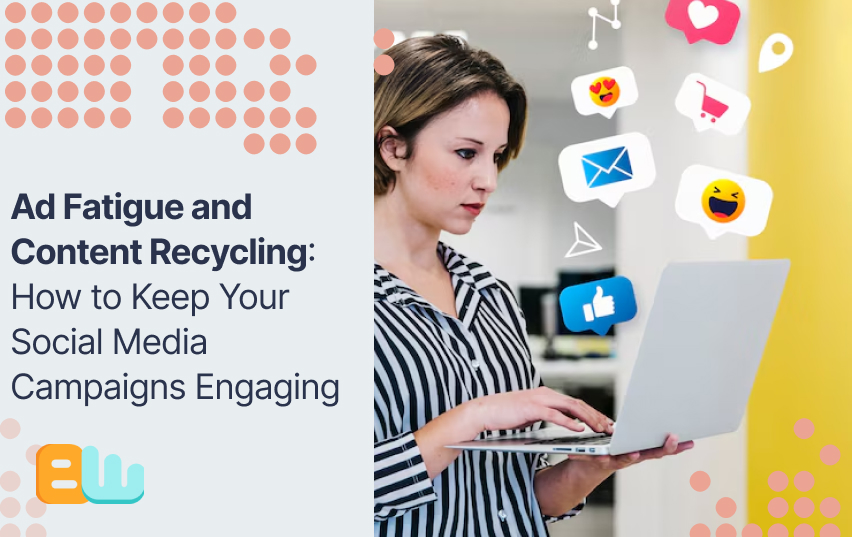
Have you observed a dramatic decline in the effectiveness of your successful social media advertisements? Ad fatigue, a common but manageable issue that impacts even the most advanced marketing strategies, is probably what you’re experiencing.
Engagement drops when your audience sees the same information over and over again. Your ROI falls, click-through rates decline, and conversion expenses increase. The good news is that you may build up your efforts without having to start from scratch by strategically recycling your material.
You’ll learn useful strategies in this post to fight ad fatigue and make the most of your current content resources. Let’s talk about how to maintain audience interest without using up all of your financial or creative resources.
Understanding Ad Fatigue in Today’s Digital Landscape

What Is Ad Fatigue and Why It Matters
When your audience growth depends to your advertisements and they just ignore them, it’s known as ad fatigue. Nowadays, users scan through hundreds of posts every day, which makes tiredness more common than it was a few years ago when social feeds were less crowded.
The effect is measurable and alarming. Your cost-per-click may rise by 25–40% as tiredness sets in, and conversion rates may decrease by comparable amounts. This is a significant waste of money for companies who make large investments in social media marketing.
Above all, the perception of your brand can be damaged by ad fatigue. Users start to associate your brand with frustration rather than value when they encounter stuff they’ve subconsciously rejected over and over again.
5 Key Warning Signs Your Audience Is Experiencing Fatigue
You don’t need advanced analytics to spot the early indicators of ad fatigue. Watch for these five warning signs:
1. Declining engagement rates compared to your historical averages
2. Increasing frequency of negative comments or reactions
3. Rising cost-per-click or cost-per-acquisition metrics
4. Decreasing clickthrough rates despite stable impression numbers
5. Shortened average view times on video content
How Frequency and Repetition Impact Engagement Metrics
Research from Facebook’s own data science team suggests that ad fatigue begins after approximately 3-4 exposures to the same content within a short timeframe. After this threshold, each additional impression yields diminishing returns.
Consider these revealing statistics:
– After 5+ exposures to the same ad, clickthrough rates drop by an average of 17%
– Frequency caps set at 2-3 impressions per week typically outperform unlimited frequency by 23% in conversion efficiency
– Content with minor variations performs 11% better than identical repeated content
More important than actual repetition is how your audience interprets it. Even though you may think of two visually similar advertisements as separate campaigns, your audience may interpret them as the same content.
The Psychology Behind Effective Content Recycling
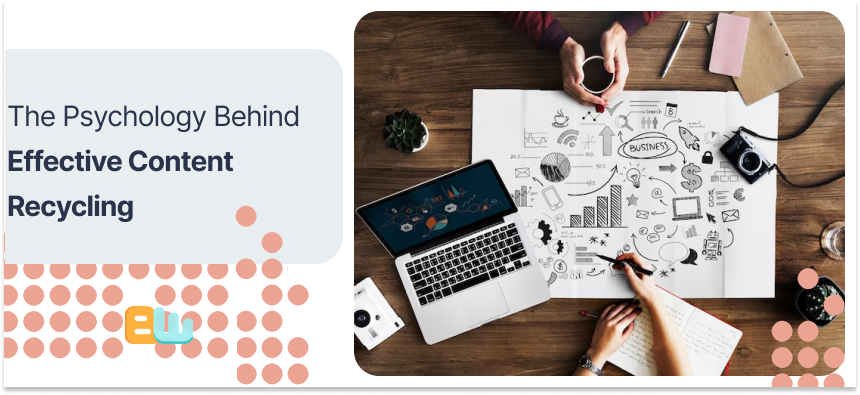
Why Audiences Respond to Familiar Yet Fresh Content
The human brain is designed to balance familiarity and novelty. Too much familiarity produces monotony, while too much novelty leads to confusion. The middle ground is known as “optimal distinctiveness” by psychologists.
This explains why slight variations of familiar content often outperform both entirely new concepts and exact repetitions. Your audience craves the comfort of recognition combined with the stimulation of something new.
For instance, Spotify introduced new visualization styles and analytics while keeping familiar aspects in its year-end “Wrapped” campaign. The outcome? increasing participation year after year while using basically the same idea.
Balancing Brand Consistency with Creative Innovation
Strong brands maintain consistent visual elements and messaging while finding opportunities for creative refreshes. This balance requires identifying which elements are core to your brand identity and which can be flexibly updated.
Consider dividing your content elements into three categories:
– Fixed elements (logo, brand colors, core message)
– Flexible elements (image styles, content format, tone variations)
– Experimental elements (new platforms, emerging trends, creative concepts)
By maintaining consistency in your fixed elements while regularly refreshing the flexible ones, you create content that feels simultaneously familiar and new. This approach protects brand recognition while combating fatigue.
Creating Emotional Connections Through Refreshed Messaging
Emotional resonance is your secret weapon against ad fatigue. When content triggers authentic emotions, audiences are more likely to engage regardless of previous exposures.
The key is understanding that different emotional angles can support the same core message. A product that saves time can be positioned to evoke:
– Relief (escape from stress)
– Joy (more time for pleasurable activities)
– Pride (accomplishing more than competitors)
– Security (reducing risk of missed deadlines)
By rotating through these emotional frames while maintaining your core value proposition, you create content that feels fresh despite promoting the same offering.
7 Proven Strategies to Combat Ad Fatigue
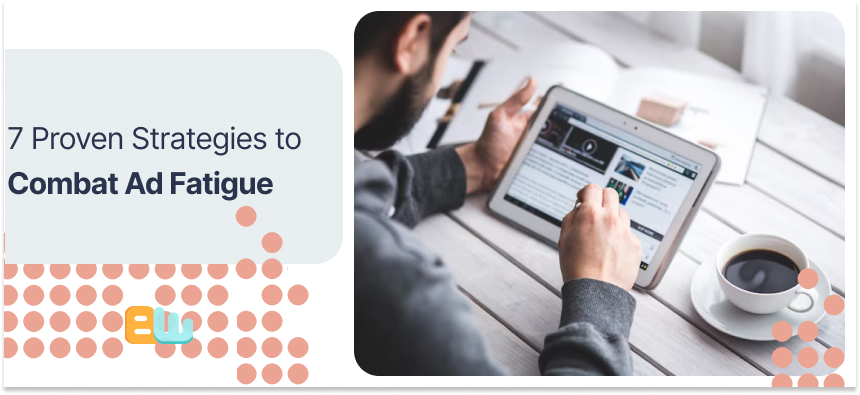
Implementing Strategic Content Rotation Across Platforms
Rather than showing the same content across all platforms simultaneously, implement a strategic rotation schedule. This approach extends content lifespan while reducing audience fatigue.
Here’s a simple rotation framework:
1. Launch new content on your primary platform
2. After 5-7 days, introduce it to your secondary platform with minor adaptations
3. After another week, repurpose for remaining platforms with more significant modifications
4. Archive for 30-60 days before considering reintroduction with refreshed elements
This amazing strategy maximizes your return on content creation investments while ensuring that no audience segment sees the same content too frequently.
Using A/B Testing to Identify High-Performing Creative Elements
Don’t guess which elements need refreshing—test methodically. Regular A/B testing reveals which creative components drive engagement and which contribute to fatigue.
Focus your tests on:
– Visual elements (images, colors, layouts)
– Copy elements (headlines, calls-to-action, tone)
– Format elements (video length, static vs. animated, interactive features)
Once high-performing elements have been identified, keep them in place and update poor ones. While correcting what doesn’t work, this data-driven approach makes sure you’re not throwing away what does.
How to Repurpose Content Without Losing Impact
Effective repurposing transforms your content’s presentation while preserving its core value. Unlike lazy recycling that merely reshares identical content, strategic repurposing reimagines how information is delivered.
For example, a customer success story can become:
– A brief testimonial quote with photo
– A mini case study with key metrics highlighted
– A short video interview clip
– An infographic showing the customer’s journey
– A before-and-after comparison image
Leveraging User-Generated Content to Maintain Authenticity
User-generated content (UGC) acts as a natural antidote to ad fatigue. When your audience sees content created by peers rather than your brand, it registers as more authentic and less promotional.
Implement these UGC tactics:
– Create branded hashtag challenges encouraging creative contributions
– Feature customer photos showing your product in real-world contexts
– Develop simple templates customers can personalize with their experiences
– Highlight customer reviews with engaging visual treatments
– Invite followers to answer questions that become content
Even when promoting the same products or services, UGC provides a constantly refreshing stream of perspectives that keeps your feed feeling current and authentic.
Data-Driven Approaches to Content Optimization
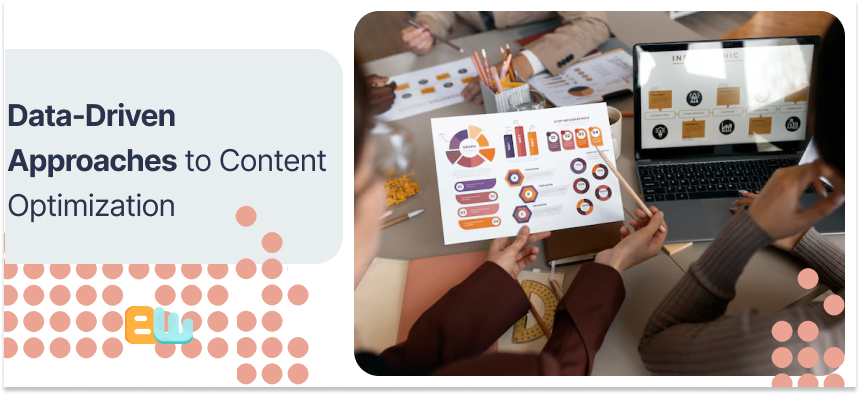
Essential Metrics to Track for Measuring Ad Fatigue
Moving beyond basic engagement metrics, these specialized indicators help identify fatigue before it severely impacts campaign performance:
– Frequency to conversion ratio: How performance changes as frequency increases
– Audience segment fatigue comparison: Which demographics show faster fatigue
– Platform-specific engagement decay: How quickly engagement drops by platform
– Creative element effectiveness over time: Which visual or copy elements maintain performance
Establish baseline measurements during peak campaign performance, then monitor these metrics weekly to catch early fatigue signals before they affect your bottom line.
Using Analytics to Determine Perfect Content Refresh Timing
Rather than refreshing content on a fixed calendar schedule, let your data determine optimal timing. The key is identifying the inflection point where performance begins declining faster than your normal trend line.
Most social platforms now offer frequency data that shows how performance changes as impressions increase. Look for these patterns:
– Early decline (1-2 exposures): Your content likely has fundamental appeal issues
– Mid-range decline (3-5 exposures): Typical fatigue pattern requiring refresh
– Late decline (6+ exposures): Unusually strong content worth analyzing for insights
When you detect the beginning of the mid-range decline, prepare your content refresh to deploy before the steep performance drop occurs.
Case Studies: Brands That Successfully Overcame Ad Fatigue
Duolingo stands out for mastering content recycling without fatigue. Their TikTok strategy revolves around their owl mascot in countless scenarios—technically the same character and brand message, but presented with enough creative variation to maintain freshness.
Their approach includes:
– Consistent character and brand elements
– Participation in trending formats
– Varying emotional tones from humorous to motivational
– Responding to comments with customized content
– Creating mini-series that evolve the same basic concept
The result? Sustained engagement despite essentially promoting the same product with the same mascot. Their secret is understanding that audiences enjoy familiar elements when presented in novel contexts.
Advanced Content Recycling Techniques for Social Media
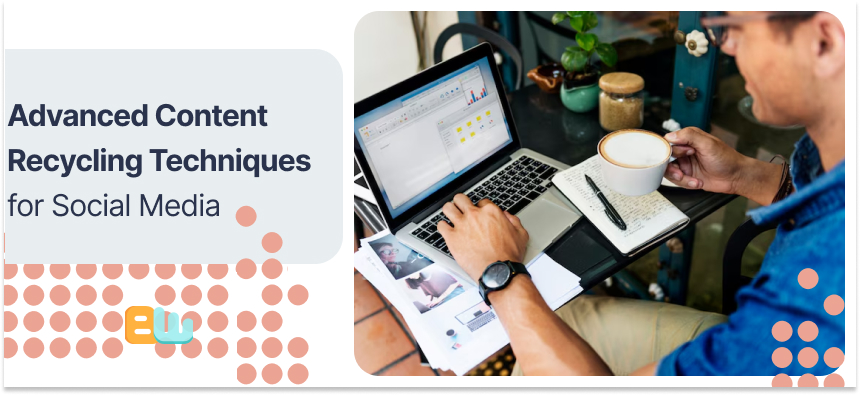
Platform-Specific Strategies for Content Adaptation
Each social platform has unique characteristics that require thoughtful adaptation. Effective recycling acknowledges these differences rather than simply resizing the same content.
Platform-specific approaches include:
Instagram:
Focus on visual refreshes while maintaining messaging. Convert static images to carousel posts or create Instagram-specific aspect ratios that frame your content differently.
LinkedIn:
Emphasize professional angles and data points. Transform casual content into more formal presentations with business statistics or industry insights added.
TikTok:
Embrace native features like text overlays and trending sounds. Shorten content dramatically and lead with the hook within the first 2 seconds.
Twitter:
Extract concise quotes or shocking statistics. Break longer content into threaded micropoints that invite discussion.
Transforming Long-Form Content Into Engaging Social Snippets
Long-form content contains multiple potential social media posts waiting to be extracted. The key is identifying standalone elements that provide value without requiring the full context.
When breaking down longer content:
1. Identify compelling statistics or data visualizations
2. Extract quotable sentences that stand alone as insights
3. Create “teaser” questions addressed in the full content
4. Develop before/after scenarios that illustrate key points
5. Design process snapshots showing “how-to” elements
A single blog post can generate 10-15 distinct social media assets when approached methodically. This isn’t merely posting the same content repeatedly—it’s highlighting different valuable elements for different audience needs.
Visual Refresh: Updating Imagery While Maintaining Message
Visual elements typically fatigue faster than messaging. Refreshing your visuals while maintaining consistent messaging offers an efficient way to combat fatigue without complete recreation.
Effective visual refresh tactics include:
– Updating background colors or patterns while keeping foreground elements
– Changing image perspective (close-up vs. wide shot of the same subject)
– Switching between photography, illustration, and graphic styles
– Applying seasonal treatments to evergreen content
– Using different demographic representations in human imagery
Even subtle visual changes can reset the “familiarity clock” in your audience’s perception, giving your core message renewed attention.
Building a Sustainable Content Calendar
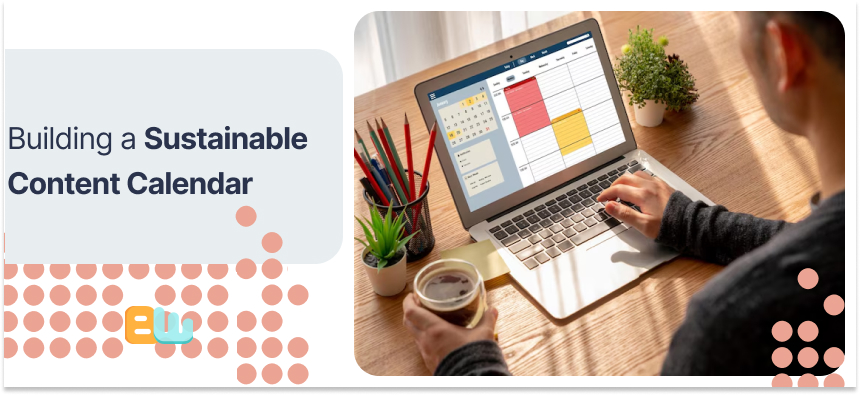
Creating a Strategic Content Recycling Schedule
Sustainable content calendars build recycling into their fundamental structure rather than treating it as an afterthought. This planned approach prevents last-minute scrambling when fatigue appears.
A recycling-friendly content calendar includes:
– Evergreen pillar content scheduled for regular refreshes
– Content theme cycles that repeat with new angles
– Designated slots for repurposed high-performers
– Buffer periods to analyze performance before recommitment
– Visual refresh milestones for long-running campaigns
Plan for approximately 30% of your monthly content to come from strategic recycling rather than net-new creation. This balance maintains freshness while maximizing resource efficiency.
Balancing Evergreen Content with Timely Updates
The most sustainable approach combines timeless evergreen content with timely contextual updates. This creates natural refresh opportunities while maintaining consistent themes.
For example, fitness brands might maintain these evergreen categories:
– Workout technique fundamentals
– Nutrition basics
– Motivation principles
– Recovery strategies
Each category then receives timely updates like:
– Seasonal application (summer workout modifications)
– Trending topic connections (linking to current health news)
– Audience question spotlights (addressing common FAQs)
– New research highlights (incorporating recent studies)
This framework makes content planning more manageable while ensuring your recycled content remains relevant to current audience interests.
Tools That Streamline Content Recycling Workflows
The right tools transform content recycling from a manual burden to an efficient system. These solutions help identify recycling opportunities and implement refreshes with minimal effort:
– Content auditing tools like Ahrefs or SEMrush to identify high-performing pieces
– Creative management platforms like Figma for maintaining brand templates
– AI-assisted copywriting tools like Jasper or Copy.ai for fresh variations
– Social scheduling platforms with content performance analytics
– Digital asset management systems for organizing previous creative elements
Even simple spreadsheet tracking can dramatically improve recycling efficiency by cataloging previous performance, usage history, and refresh opportunities.
Future-Proofing Your Social Media Campaigns

Emerging Trends in Social Media Content Consumption
The content consumption landscape continues evolving, with several trends particularly relevant to fighting fatigue:
– Shorter attention windows requiring faster value delivery
– Increased preference for authentic, less-polished content
– Growing sophistication in recognizing paid vs. organic content
– Rising expectations for personalized and relevant experiences
– Preference for multi-format content engagement options
These trends point toward a future where varied, authentic content delivered in multiple formats will outperform even high-production single-format campaigns. Building these principles into your content strategy now prepares you for coming shifts.
How AI and Automation Can Prevent Ad Fatigue
AI tools are increasingly capable of identifying fatigue signals and suggesting effective refreshes. Forward-thinking brands are already implementing:
– Predictive analytics that forecast when fatigue will occur
– Dynamic creative optimization adjusting elements in real-time
– Personalization engines serving variable content based on user history
– AI-generated variations maintaining brand voice with fresh phrasing
– Automated cross-platform adaptation preserving message while optimizing format
While human creativity remains essential, these technologies help extend content lifespan by delivering precisely timed and targeted refreshes before fatigue impacts performance.
Preparing Your Strategy for Evolving Platform Algorithms
Social platforms continuously modify their algorithms to prioritize fresh, engaging content. Future-proof strategies acknowledge these algorithmic preferences by:
– Creating content with built-in variation elements
– Developing modular components that can be reassembled
– Establishing clear refresh triggers based on performance thresholds
– Building responsive workflows that can quickly adapt to algorithm changes
– Maintaining platform-specific content variations
By designing content systems with flexibility and refreshment in mind, you position your campaigns to thrive despite ongoing algorithm evolution.
Measuring Success: Beyond Basic Engagement Metrics
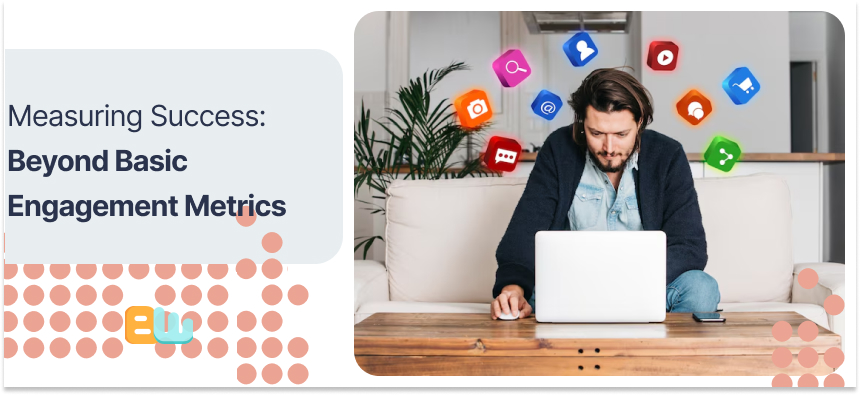
KPIs That Truly Indicate Healthy Content Performance
Look beyond surface-level engagement to these more meaningful indicators of content health:
– Engagement retention rate: How well engagement maintains over time
– Frequency resistance: How performance holds up at higher view frequencies
– Cross-platform effectiveness: Performance consistency across channels
– Comment sentiment evolution: How comment tone changes over time
– Conversion efficiency by exposure level: How conversion rates change with repeated exposures
These metrics reveal whether your content strategy is building sustainable audience relationships or merely generating temporary attention.
Conducting Effective Content Fatigue Audits Quarterly
Quarterly fatigue audits provide structured opportunities to evaluate and refresh your approach. An effective audit examines:
1. Performance trends by content type and format
2. Audience segment response variations
3. Competitive content analysis for fresh approaches
4. Platform-specific fatigue patterns
5. Creative element effectiveness over time
Schedule these audits as formal calendar commitments rather than reactive measures when performance drops. This proactive approach prevents fatigue rather than merely responding to it.
Connecting Content Freshness to Conversion Metrics
Ultimately, the true measure of successful content recycling is its impact on business outcomes. Establish clear connections between content freshness metrics and conversion results by:
– Tracking conversion rates by content freshness date
– Comparing acquisition costs between fresh and aging content
– Measuring purchase value differences between new and recycled content
– Analyzing customer retention rates from various content sources
– Identifying lifetime value patterns related to content exposure variety
These connections help justify investment in regular content refreshes by demonstrating tangible business impact beyond engagement metrics.
Keeping Your Social Media Content Fresh: The Path Forward
Ad fatigue isn’t going anywhere. Maintaining audience interest on increasingly crowded social media platforms requires careful content recycling techniques that strike a balance between familiarity and novelty.
The good news? You don’t have to produce brand-new stuff all the time. You can keep your content alive and maintain audience engagement by putting data-driven optimization, platform-specific adjustments, and planned schedules into practice.
Keep in mind that successful recycling involves rethinking rather than repetition. You may develop campaigns that are sustainable and continue to produce results long after they are first launched by creatively and purposefully transforming your current content assets.
Which methods of content recycling have been most effective for your campaigns? Leave a comment below with your experiences.
#SocialMediaStrategy #ContentMarketing
